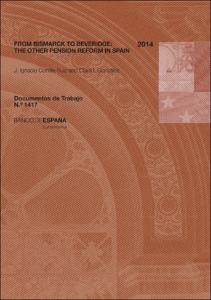From Bismarck to Beveridge : the other pension reform in Spain
Autor
Fecha de publicación
22-jul-2014
Descripción física
38 p. : tab., gráf.
Resumen
El envejecimiento de la población es un proceso imparable que continúa suponiendo un reto para la sostenibilidad del sistema de reparto de pensiones en la mayoría de los países desarrollados, incluida España. Gran parte de estos países necesitan llevar a cabo reformas en sus sistemas de pensiones para controlar su gasto y, en algunos casos, ya han empezado. Sin embargo, existen otros mecanismos que suponen cambios en parámetros del sistema, que al ser percibidos como secundarios por los ciudadanos no son apreciados como tal reforma. Este es el caso de modificaciones en los topes de las pensiones y de las bases de cotización y que en España se ha denominado, por parte de los expertos en pensiones, como la «Reforma silenciosa». El objetivo de este documento es analizar las implicaciones que este tipo de reforma tendría en el caso de España, siendo el primer trabajo que cuantifi ca y evalúa su potencial impacto en dicho país. Con este fin se ha empleado un modelo de proyección contable, con generaciones solapadas y agentes heterogéneos, de gastos del sistema de pensiones español hasta el año 2070. Los resultados obtenidos muestran que este tipo de reforma no solo tendría potencial para contener el gasto futuro, sino que también podría suponer un cambio en la naturaleza del sistema al ser capaz de convertir un sistema contributivo (o Bismarckiano) en otro de tipo asistencial (o Beveridge). Esto último podría tener importantes consecuencias, pues ambos sistemas persiguen objetivos distintos. En el documento también se pone de relieve que las características institucionales que hacen posible este tipo de reforma en España existen al mismo tiempo en la mayoría de los países desarrollados con sistemas de pensiones tipo Bismarckiano. Y por lo tanto, creemos que las lecciones aprendidas en este documento para el caso español podrían ser de utilidad para otros países
Aging is an unstoppable process and it remains a major challenge for the sustainability of the PAYG pension system in most developed countries, including in Spain. Many countries need to introduce reforms of their pension systems in order to control their expenditure, and in some cases this has already begun. However, there are other sorts of changes to certain parameters that are perceived as secondary, e.g. the different path of minimum and maximum pensions, and the upper and lower caps on contributions. This has signifi cant implications for the distributive structure of the social security system that cannot be readily perceived by the population. That is why some economists in Spain refer to it as the “Silent Reform”. The aim of this paper is to analyse the consequences this type of reform would have in Spain
indeed, it is the fi rst paper to actually quantify and evaluate the potential impact it would have on the country. We have used an accounting model with heterogeneous agents and overlapping generations in order to project pension expenditures up until 2070. The results show that this kind of reform could potentially contain future expenditure and could also change the nature of the pension system from a contributory or Bismarckian-type system into an assistential or Beveridgean-type one. This change could have signifi cant consequences as both systems have different objectives. The paper also shows that the institutional characteristics that make this kind of reform in Spain feasible are also present in most developed countries with Bismarckian pension systems. Therefore, we believe that the lessons learned in this paper on this kind of reform could well prove useful to other countries
Aging is an unstoppable process and it remains a major challenge for the sustainability of the PAYG pension system in most developed countries, including in Spain. Many countries need to introduce reforms of their pension systems in order to control their expenditure, and in some cases this has already begun. However, there are other sorts of changes to certain parameters that are perceived as secondary, e.g. the different path of minimum and maximum pensions, and the upper and lower caps on contributions. This has signifi cant implications for the distributive structure of the social security system that cannot be readily perceived by the population. That is why some economists in Spain refer to it as the “Silent Reform”. The aim of this paper is to analyse the consequences this type of reform would have in Spain
indeed, it is the fi rst paper to actually quantify and evaluate the potential impact it would have on the country. We have used an accounting model with heterogeneous agents and overlapping generations in order to project pension expenditures up until 2070. The results show that this kind of reform could potentially contain future expenditure and could also change the nature of the pension system from a contributory or Bismarckian-type system into an assistential or Beveridgean-type one. This change could have signifi cant consequences as both systems have different objectives. The paper also shows that the institutional characteristics that make this kind of reform in Spain feasible are also present in most developed countries with Bismarckian pension systems. Therefore, we believe that the lessons learned in this paper on this kind of reform could well prove useful to other countries
Publicado en
Documentos de Trabajo / Banco de España, 1417
Materias
Aging population; Pension reform; Beveridgean type; Bismarckian type; Accounting projection model; Overlapping generations; Envejecimiento; Reforma de pensiones; Sistema tipo Beveridge; Sistema Bismarkiano; Modelo de proyección contable; Generaciones solapadas; Seguridad social y programas de asistencia social; Distribución de las rentas y riquezas de las personas; España
Aparece en las colecciones:












